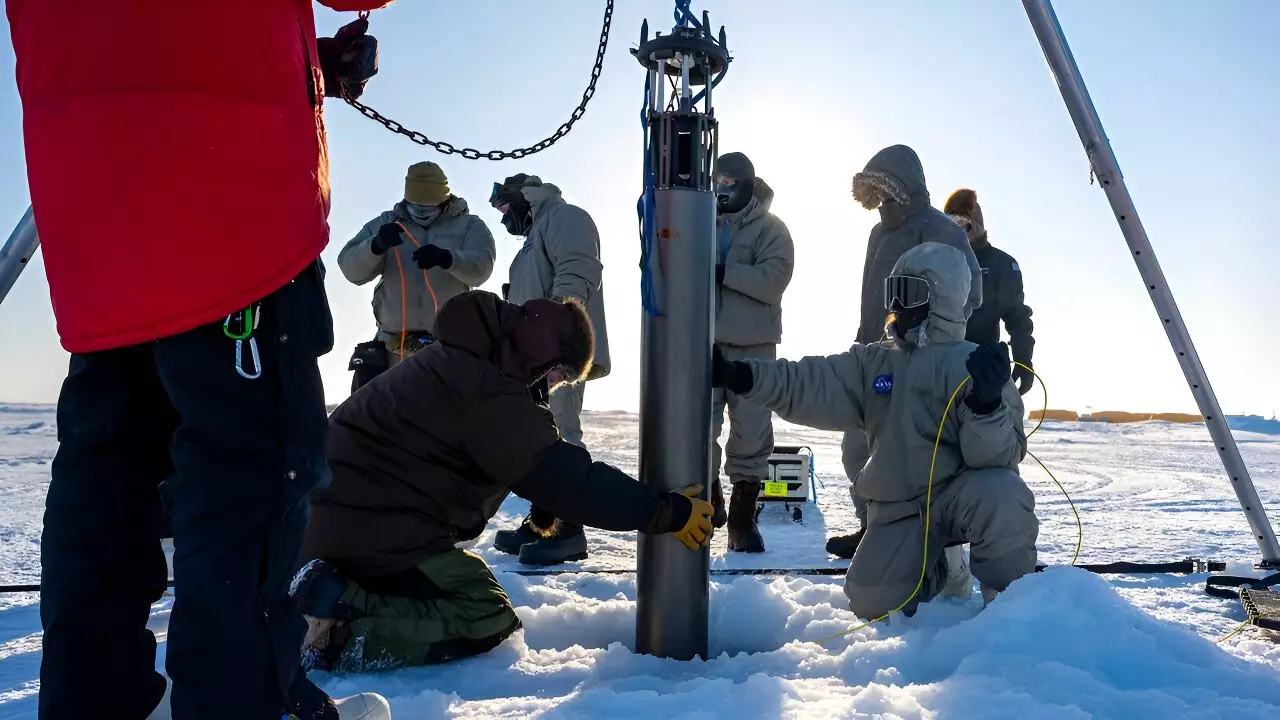In a remote and hostile environment such as the Beaufort Sea, NASA engineers are making strides into the complexities of Antarctica’s icy depths. This effort shines a spotlight on the melting ice sheets that hold secrets crucial to understanding global climate change. The IceNode project aims to create a fleet of autonomous robots designed to explore beneath Antarctic ice shelves, gathering valuable data about how quickly ice is melting. This quest for knowledge is not just academic; it has substantial implications for global sea-level rise, threatening the stability of coastlines around the world.
During a March 2024 expedition to the Beaufort Sea, engineers from NASA’s Jet Propulsion Laboratory (JPL) tested their prototype robots in extreme conditions, navigated by a tether through a thick layer of ice. Below the icy surface, the cylindrical robots worked diligently, collecting test data that would pave the way for future explorations. Unlike traditional approaches to studying these environments, which often rely on manned expeditions or satellite imagery, IceNode represents a novel technological leap. This robot fleet facilitates direct monitoring of melting below the ice sheets, targeting critical areas that are otherwise inaccessible to scientists.
The challenge of gathering real-time data has long intrigued researchers. IceNode is being developed with insights from both space exploration and the complexities of oceanic behavior. Engineers have designed the robots to measure key variables such as salinity and temperature while utilizing innovative navigation techniques. Without onboard propulsion, the robots ingeniously leverage ocean currents to drift toward the ice shelves they are meant to study.
Antarctica’s ice sheets are not merely frozen landscapes; they are indicators of broader climate trends. Current models estimate that if all of Antarctica’s ice were to melt, it could lead to a staggering 200 feet (approximately 60 meters) increase in global sea levels. This dramatic possibility emphasizes the urgency behind IceNode’s mission. The intricate interactions between the ocean and ice represent noticeable gaps in our climate models, primarily because they occur in geographical locations that are perilously difficult to monitor.
Ice shelves act as natural barriers to the flow of ice from land into the ocean, a balance critical to maintaining current sea levels. As the warming waters of the oceans encroach upon these floating ice structures, scientists aim to measure how quickly this melting process is occurring, particularly in the “grounding zone,” where floating ice meets land and ocean. The IceNode robot fleet could provide vital data to better understand how this melting process occurs and what it means for future sea levels.
IceNode’s robots are specifically designed to navigate the icy underworld autonomously. Each robot stretches about 8 feet (2.4 meters) in length and 10 inches (25 centimeters) in diameter, featuring a novel landing gear that attaches securely to ice sheets. This design innovation allows the robots to make direct measurements at the melting interface, collecting data crucial for refining climate models.
These autonomous vessels will release from boreholes or vessels and ride along ocean currents beneath the ice shelves, where they can continuously gather information over the course of a year. Once their data collection is complete, the robots will detach from the ice and transmit their findings back to researchers via satellite. According to Paul Glick, JPL’s principal investigator for IceNode, this method presents a low-cost solution for conducting extensive scientific investigations in areas that safely elude conventional methods.
Initial tests have yielded promising results, with previous deployments in varied locations, including California’s coastal regions and the frigid depths of Lake Superior. The Beaufort Sea test represents a significant milestone, serving as the first polar deployment for the prototype. Despite encountering challenging conditions, such as temperatures plunging to minus 50 degrees Fahrenheit, the robotic fleet successfully gathered crucial data during the expedition.
This ongoing process of development and refinement may pave the way for future explorations. As Glick emphasized, the objective is unwavering: to further refine the technology, continue rigorous testing, and ultimately deploy a full fleet of robots underneath Antarctic ice shelves. The data collected will be instrumental for scientists seeking to understand the intricacies of climate change, particularly concerning ice melt rates and their implications for our planet’s oceans.
The IceNode project exemplifies a proactive approach to one of the most pressing scientific questions of our time: How rapidly is Antarctica melting, and what does this mean for our planet’s future? The pioneering technology behind IceNode not only fulfills a critical research need but also serves as a reminder of the adaptability and ingenuity of humans in the face of nature’s greatest challenges. As the world grapples with increasingly concerning climate projections, efforts like IceNode underscore the importance of scientific exploration and innovation in preserving our planet’s future.

